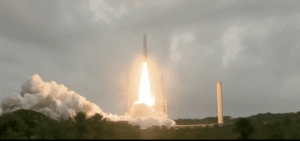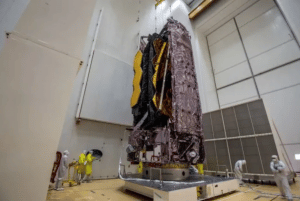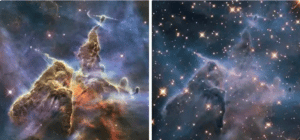James Webb (Webb) space telescope embarks on a journey
On December 25, 2021, at 0920 local time in French Guiana, 2020 GMT, the James Webb Space Telescope (JWST, hereafter: Webb Telescope) was launched aboard Ariane 5 from the French Guiana Space Launch Center.
Note: The James Webb Telescope was translated by the Committee on Astronomical Terminology and named the James Webb Space Telescope, a slight departure from the previous terminology.


Figure 1. James Webb Space Telescope launch process (Source: NASA TV)
Because of its huge telescope size, the Webb telescope is launched in a folded state. After entering space, the Webb telescope will unfold its sunshade and mirror, and the following month it will fly to the second Lagrangian point of the Sun-Earth, 1.5 million kilometers away from Earth, where it will settle and carry out its exploration of the universe.

.png)
Figure 2. JWST folded state (Source: JWST)
The Webb telescope, long considered the successor to the Hubble telescope, has an aperture of 6.5 meters and a primary mirror composed of 18 small mirrors with gold-plated surfaces, which collects light more than four times the capacity of Hubble but weighs less than the Hubble telescope. Unlike the Hubble telescope, the Webb telescope will carry out observations in the near- to mid-infrared wavelengths. It has unprecedented detection sensitivity and resolution in the wavelength range in which Webb operates. The Webb telescope will make it possible to record light from the first galaxies in the universe, which existed 400-800 million years after the birth of the universe in the early years of the universe; help us understand a detailed picture of the evolution of galaxies over the past 13 billion years; detect the first births of stars; bring key information about the formation of planetary systems and help us examine the atmospheres of exoplanets in detail.

.png)
Figure 3. Comparison of the Ship Base Nebula in visible light (left panel) and infrared light (right panel). Infrared light is able to penetrate the dust cloud and reveal the view behind it. Both images were taken by Hubble (Source: NASA/ESA/STScI/Goddard)
Before the Webb telescope officially begins observing, a series of telescope adjustments will be made at the second solar-terrestrial Lagrangian point, the main observing instruments will be gradually cooled to operating temperature, and instrument inspection and calibration work will be completed. The first 286 Webb science observing projects are now publicly available on the Webb website, spanning a wide range of topics from the early universe, galaxy formation, dark matter research, to star formation, planetary science, and solar system research. Some of these large observational programs will be released to scientists around the world soon after the observations are completed.
The history of the Webb telescope's construction has had many twists and turns, spanning three decades and more than 40 million hours of work by thousands of scientists, engineers and technicians. Its successful launch will likely open a new chapter in several fields of astronomy.
Source: @National Astronomical Observatory official account
Time: December 25, 2021
